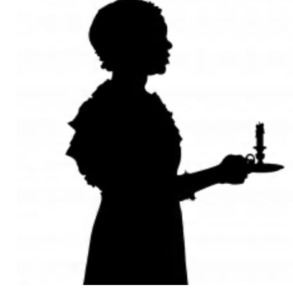Eliza

Eliza’s story is very bare: She was born—documents indicate where and when and who her mother was. She lived—the records show the people who enslaved her. Handwritten legal papers document events that were going on around her that affected her life. Beyond that, Eliza’s story has not been uncovered.
Eliza was born to a woman named Monarchy (or Monica) around 1816 in Ballston—the intersection of Glebe Road and Wilson Boulevard that was originally known as Birch’s Cross Roads and, later, Ball’s Cross Roads or X Roads. Archibald J. Taylor and his wife Elizabeth enslaved Eliza and her mother on a 36-acre farm “at the intersection of the crossroads.”
Elizabeth was the daughter of two large landowning and slaveowning families in the area—Joseph Birch of the Birch Family that once owned 58 acres in Rosslyn including the land where Iwo Jima Memorial and Netherlands Carillon stand today; and Janet (Jenett) Bowmaker Robertson of the Robertsons—whose father was once the largest landowner in the Arlington area after being awarded original land grants beginning in 1724 from Thomas Fairfax, 6th Lord Fairfax of Cameron. Just as Janet did, Elizabeth likely inherited landholdings and enslaved people from her family.
When Archibald died around 1817, an appraisement valued Eliza (age 1) and Monarchy at $218 (about $5,000 in 2024 dollars), along with another enslaved girl, Luiza, or Louisa (age 15), valued at $300 ($6,900).
Five years after Archibald’s death, in November 1822, Elizabeth executed a contract with her brother Samuel Birch to sell and put into a trust the people she enslaved, Eliza (age 6), Monica, and Louisa, as well as Elizabeth’s farmland and tenements. Samuel paid a small fee of $1 and held these assets in trust for the use and benefit of her children. He did not live with her on her land, but presumably her children did. He owned his own large tract of land, spanning from today’s Langston Boulevard to Little Falls Road and from North Sycamore Street to North Lexington Street.
In 1825, records show that Samuel Birch, Elizabeth Taylor, and the children and heirs of Joseph Birch, among others, freed several enslaved people (Ailce and her children, Fanny, Betsey [Primus] and James; Betsey’s son, Henry; and Sarah [Sarah Taylor Carter], and the child of Ailce’s deceased daughter, Winny), but Eliza (age 9), Monarchy, and Louisa were not among them.
In 1844, Elizabeth died without a will, and one of her sons, William H. Taylor, who had gone bankrupt in 1842, “clandestinely and fraudulently” and “unlawfully” “took into his possession”—that is, abducted, or stole—Eliza (age 28) from the land at the crossroads.
Eliza had “grown to woman-hood” and had two children, Mary and John; they, along with Monarchy (“a black woman slave called Monica”) and Louisa (“a yellow woman slave”), were still in Samuel’s possession/trust. Samuel believed William wanted to sell Eliza to traders and “apply the proceed of sale to his own individual purposes.” Samuel filed a bill of chancery—a complaint—on September 4, 1844, with the United States Circuit Court for the County of Alexandria and District of Columbia (today’s Arlington), seeking an injunction to prevent the sale.
Together with enslaver Wesley Carlin—part of the Carlin family associated with the Ball-Sellers House—he put up a $600 bond, as part of the legal process to keep William from selling Eliza, as well as to cover court fees.
Meanwhile, in 1846, another one of Elizabeth’s children, Martha Ann, sued her brother William for an equitable distribution of their mother’s land and property. The court appointed a slate of commissioners to determine the equitable distribution—one of which was Arlington enslaver Richard Southern. The commissioners handled the distribution of land but noted in November 1847 (when Eliza was 31), “The negroes were not brought forward for division by the parties; but they were claimed by William H. Taylor as his own property.”
No documentation found to date has indicated what became of Eliza—whether she stayed with her abductor William Taylor or was returned to the trust of Samuel Birch; whether she lived to be freed in 1865 (when she would have been age 49), or whether she died before freedom; or whether she married and took someone else’s name. But Arlington historian Eleanor Lee Templeman indicated that five or six “colored servants” are buried in one corner of the Birch-Payne cemetery in Arlington. The three enslaved people who are named on a modern tombstone do not include Eliza or her children, however. This burial ground is where Samuel Birch, two wives, and their children and grandchildren are buried on his former estate at Sycamore and North 28th streets. Arlington County allowed most of the cemetery—once an acre or more—to be subdivided for housing; only about a third of an acre still exists, and most of the tombstones are gone.
Sources include:
Ancestry.com resources, including Samuel Birch’s and William H. Taylor’s 1850 and 1860 slave census records; and Virginia, US Wills and Probate Records, 1652-1900; Alexandria County, Account Book 2, p. 197.
Alexandria Gazette and Virginia Advertiser. (1842, March 3). “William H. Taylor Notice.”
“Chancery Cases: Samuel Birch v. William H. Taylor, 1845-011 Arlington County” files from Alexandria County (Va.) Chancery Causes, 1753-1911. Local Government Records Collection, Arlington County Court Records. The Library of Virginia, Richmond, Virginia.
Clark, C. (n.d.). “A Tour of the Birch Family Properties.” Arlington Historical Magazine. https://arlingtonhistoricalsociety.org/wp-content/uploads/2020/02/2014-2-Birch.pdf
Chancery Records Index. Virginia Memory. Library of Virginia. https://www.lva.virginia.gov/chancery/case_detail.asp?CFN=013-1845-011
Slave Manumissions in Alexandria Land Records, 1790-1863. (Compiled by Timothy J. Dennee, 2001 and 2004). The Friends of Freedmen’s Cemetery. https://www.freedmenscemetery.org/resources/documents/manumissions.shtml
Templeman, E.L. (1959). “Ballston’s Beginnings.” https://arlingtonhistoricalsociety.org/wp-content/uploads/2016/02/1959_6Ballston.pdf
Thomas, J. (2020, March 29). “Birch Family Collection: Part of Arlington’s Oldest Family.” Arlington Historical Society. https://arlingtonhistoricalsociety.org/2020/03/birch-family-collection-part-of-arlingtons-oldest-family/
The Virginia Department of Historical Resources. (1990). Virginia Family Cemeteries – Preliminary Survey. https://www.dhr.virginia.gov/wp-content/uploads/2021/11/VA-074_Virginia_Family_Cemeteries_1990_DHR_surveys.pdf
Williamsburg Neighborhood Conservation Plan. (2001, January). Arlington County, VA. https://www.arlingtonva.us/files/sharedassets/public/v/1/projects/documents/nc_williamsburg_plan.pdf


